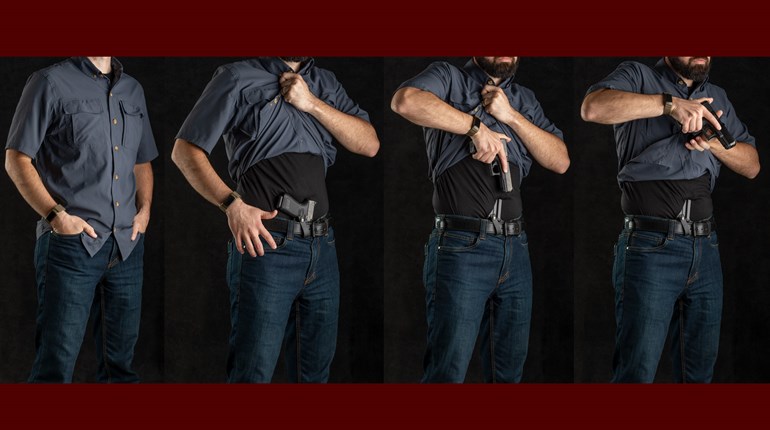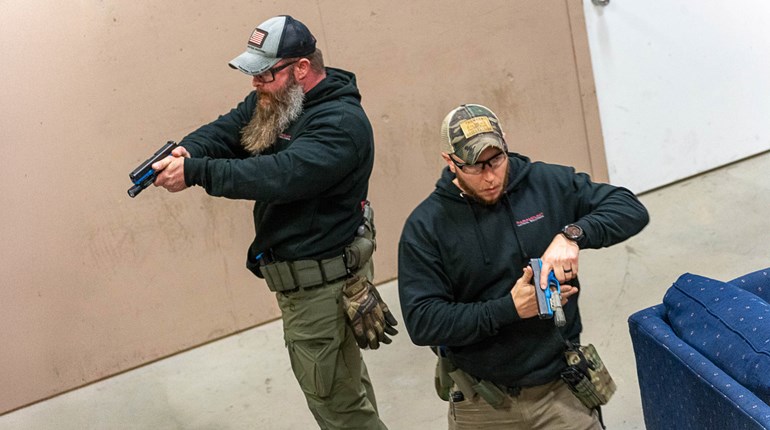
This is the third of five articles about how to pick the right handgun to carry for defensive purposes. Deciding what to carry is a personal decision, but one thing you should consider is the type of situation you’ll be in. Frank Jardim chooses from one of four guns when he arms himself, explaining the advantages of each in given circumstances. You can read earlier parts here.
Smith & Wesson .38 Special, Model 10, K-Frame, 4-inch revolver
Primary Use: Better urban or rural protection for me when clothing, weather and venue permit the carrying of a larger handgun.
Holster: In the colder months when I’m working outside, I now carry this revolver completely concealed in the built in pocket of my American Rebel brand Cartwright work coat. It looks and wears like a heavy canvas, high quality, Carhartt coat, but the flannel lining has a Velcro and snap secured gun pocket on each side that blends in to the point that I can work with the coat unzipped and nobody would every guess I have a full size handgun on me. Despite the deep concealment, the gun is quite quick to deploy if using both hands. Drawing with one hand is a naturally slower two-step process, first pulling open the pocket and then grabbing the gun grip.
When I carry the 4-inch revolver in a recreational environment (e.g., going out to dinner or a movie theater), I use an old Bianchi X15 vertical shoulder holster. I hardly ever see these spring clip vertical holsters anymore. Though they are very fast to draw from, mine isn’t as secure as the current model (available at safariland.com) which has a retaining strap added. You could do jumping jacks with the new model. I still prefer a vertical shoulder holster to the horizontal "Miami Vice" type. In my opinion the latter violates one of the main rules of gun safety. Keep the gun pointed in a safe direction.
Ammunition: .38 Spl. +P, 158 gr. LSWCHP. Wags will criticize this caliber but it is easy to shoot well and not prone to over-penetration like higher velocity cartridges. I’d rather get six hits with a .38 Spl. than one hit and five misses from a .357 Mag. The lead semi-wadcutter hollow point was adopted by the FBI in the 1960s and found to be more effective than jacketed hollow points.
Pros/Cons: Potent caliber, great handling and shooting characteristics, compact size for chambering thanks to forged frame and tapered barrel. Mine is an accurate, mechanically sound, early 1970s police trade-in, and like a beat up car, I can't do anything to hurt its appearance. A gun that looks well used can send an important message to the person it's being aimed at. "I’ve been shooting a long time and probably should be left alone." For double action shooting, the S&W trigger pull is the smoothest and I prefer it over all others. My pistol has the old style, slim, tapered barrel and better balance than the thicker barreled versions that followed it; but is still very controllable in rapid double action shooting with standard velocity loads. As medium frame traditional double action revolvers in medium calibers go, this gun is at the top of the evolutionary chart. The downside of revolvers for a new shooter is the extra practice it takes to master double action shooting. If I hadn’t already shot thousands and thousands of rounds through S&W K-frames like this, I wouldn’t carry it. My self-defense revolver would be the Chiappa Firearms Rhino, which is more controllable and makes .357 Mag. rounds feel like .38 Spls.
Check americas1stfreedom.org tomorrow for Part 4.


































